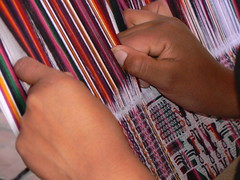Sucre - in between dinos and weavers
Red is for the blood shed from the many heroes that fought for the Bolivian independence. Yellow is for the country’s richness in minerals. Green is for the nature.
As Sucre is the official capital in Bolivia it makes sense that this was the place where we figured out why the Bolivian flag is bearing its colours.
We figured it out, wandering around the Casa Libertad, a colonial building dedicated to Bolivia’s struggle for independence and where until today – the government constitutes every year.
The place ooze with details from the Bolivian history, from antique maps showing the borders of Bolivia as they used to be (with coastline!), blood stained flags from the battlefields, the many wander sticks of the different presidents, ashes of the most famous female warrior, weapons, a copy of the independence contract and portraits of all the 66 different presidents that Bolivia have had in their relatively short period of democracy – a fact that actually have given Bolivia a place in the Guinness book of records: The country with the greatest amount of presidents in shortest time! Nr. 66, Evo Morales is the first indigenous president ever, making him a quite special finale so far. Other interesting president facts, was that Bolivia’s first president was from Venezuala, and that Bolivia for a short period had a female president. Women in Bolivia did have courage! One of the most spectacular Bolivian warriors was a woman. She participated in more than 20 important battles.
A good friend of ours told the story of many women, old people and children that defended the Cochabamba region, whilst their men had been called out to fight battles further away. The women did not just sit with their hands in their laps.
Here we also discovered why all the Indians are wearing knee short wide skirts: Fashion! The Spanish queen used to wear it during the colonization and it sticks until this day.
The region around Sucre is famous for its weavings. ASUR (a local NGO) have since the mid 80íes successfully been working with the local communities with the aim to preserve the local tradition of weaving. They have established a combination of a museum, work shop and shop. It’s an adorable place where we got a good understanding of the work and the art. The level of detail is stunning and we ended up buying a piece of their weaving for the wall - a genuine piece of art.
Sucre “The white city of South America” was an interesting experience, - also from an architectonical point of view: The centre of the city only consists of white buildings, and local law requires a yearly cleaning of the buildings to keep them white.
We also went to the Carl Orko. A huge area full of dinosaurs! Well…the dinosaurs are full sized plastic sculptures – but never the less, with a good imagination you could easily picture them alive…. Well… maybe we have seen Jurassic park too many times.
Carl Orko is the world’s biggest known collection of dinosaur footprints. Within an area of 1.5 km x 150m, more than 5000 prints from at least 150 different dinosaurs can be seen.
Unfortunately, we were not allowed to come really close to the foot prints – but standing 100 meters from the huge wall with rows of giant million year old footprints can be a pretty amazing view anyway!
Until this day; the owners continue to discover new foot prints. Last month they found 600 “new” foot prints.
After Sucre we went on to Santa Cruz.


0 Comments:
Post a Comment
<< Home